Chapter 5: Enabling the current and future workforce
A transformed workforce will underpin stronger institutional capacity, including to undertake deep research, evaluation and data analytics. It will also be critical to integrated policy approaches that take a strategic view of Australia’s interests across economic, social, security and international domains.
Independent Review of the APS: Priorities for Change87
As this report has already highlighted, the operating environment for the public service is rapidly evolving on a number of fronts. Changing public demands and expectations of government are giving rise to policy and service design and delivery challenges. Advances in technology have led to increasing moves towards digitalising service delivery.
The collection and management of data is growing in importance, along with better use of data and analytics to inform policy, compliance and service delivery. Generational changes in society are being reflected in the workforce and labour supply challenges for critical or emerging roles and functions are becoming more urgent.
To respond to these challenges and opportunities, the APS workforce of the future will need to be more empowered, mobile, diverse, adaptive and capable. APS workplaces will need to be better connected and characterised by continuous learning and feedback. As an employer, the APS will need to attract, reward and retain the best talent, and will increasingly compete with other jurisdictions and sectors to fill critical and emerging roles.
In addition, the APS will not be immune from the labour market disruption that has already started due to advancements in artificial intelligence, machine learning and big data. Reskilling some segments of the APS workforce will be an important aspect of workforce planning to manage job transitions for employees as skills requirements change. Lifelong learning and ongoing skills development will continue to underpin capability development as the APS grapples with the changing nature of work. To work towards these objectives, an APS-wide workforce strategy is being developed. Announced in the 2018–19 Budget, this strategy will help position the APS as an employer of choice, with a high-performing, diverse and flexible workforce, mobilised when and where needed. The strategy aims to drive modern workforce practices, inform future capability requirements and help prepare public sector employees for the future.
The workforce strategy aims to better prepare the APS for the increasing pace of social, technological and environmental change, and ensure workforce planning efforts are guided by a shared vision. The strategy will also focus on outcomes that benefit the APS as a whole and encourage strategic leadership that is collaborative and future focused to address workforce impacts.
It is envisaged that the workforce strategy will have an impact across a wide spectrum of workforce capability areas, including recruitment and retention, learning and development, and leadership. However, strategy implementation will rely heavily on HR functions across the APS. Capability gaps in strategic HR roles will therefore need to be filled, including through the development of a professions model, where professional capabilities, career pathways and development are well defined and support high performance, talent management and succession planning.
Attraction and retention
The APS is competing in a contested market for talent and individuals’ expectations of their employers continue to evolve. To address critical capability gaps in this environment, the APS needs to understand what attracts people to the service, position itself as an employer of choice, and adopt strategic and targeted recruitment at all levels.
APSED shows that during 2018–19, 8,564 people were engaged as ongoing employees in the APS, a fall of 4.9 per cent compared to 2017–18. Most engagements were at APS 6 (19.1 per cent), APS 4 (18.4 per cent) and APS 5 (17.8 per cent) classification levels. This trend reflects that APS 4–6 represented 55.5 per cent of the whole APS workforce in 2018–19. Approximately 40 per cent of people engaged as ongoing employees were under the age of 30, compared to 10.4 per cent of the ongoing workforce. In terms of gender, 59.7 per cent of newly engaged employees were women and 40.2 per cent men (0.1 per cent identified as Gender X). However, as Figure 5.1 shows, engagement gender proportions vary significantly at different classification levels.
Figure 5.1: Proportion of APS employee engagements, by classification and gender

Source: APSED
The 2019 APS employee census sought views from employees with less than one year’s service (that is, graduates and other recent starters) about what attracted them to work in the APS. Figure 5.2 shows that employment conditions continued to be a strong pull factor towards APS employment, far more so than remuneration. Other factors valued by new starters were the alignment between the work and their skills/experience, the type of work offered, long-term career progression, and security and stability.
Figure 5.2: Reasons for joining the APS, graduates and recent starters
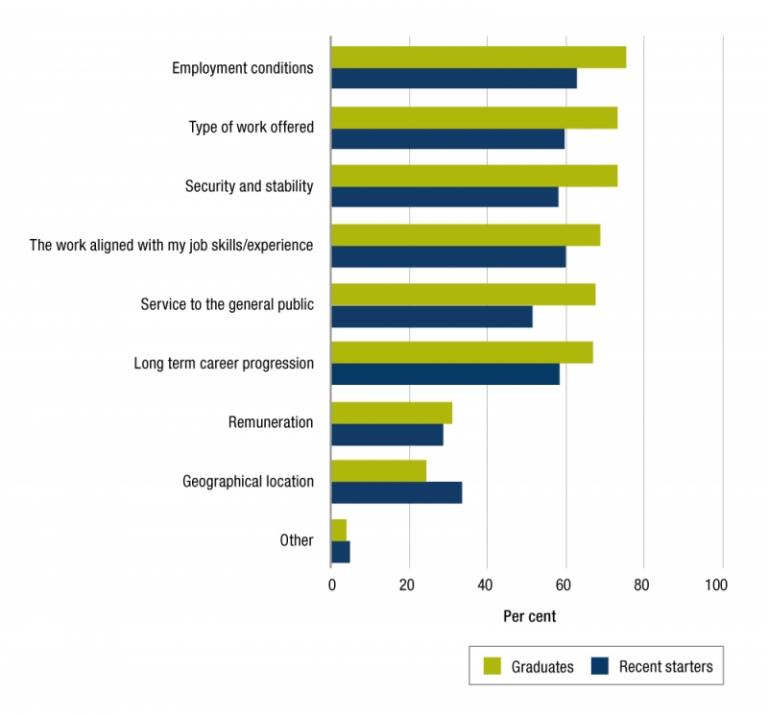
Note: Recent starters, in this case, are respondents who indicated their total length of service in the APS was less than one year. As respondents could select more than one option, percentages may not total 100 per cent.
Source: 2019 APS employee census
The 2019 APS employee census also explored employees’ career intentions. Approximately half of respondents indicated they had applied for a job in the previous 12 months. A greater proportion of respondents indicated that they had applied for a job in their own agency (38 per cent) than in another APS agency (18 per cent) or outside the APS (12 per cent). At the same time, 50 per cent of all respondents expressed a desire to stay with their agency for at least three years, while 25 per cent wanted to leave their agency within the next 12 months (Figure 5.3).
Figure 5.3: APS employee career intentions
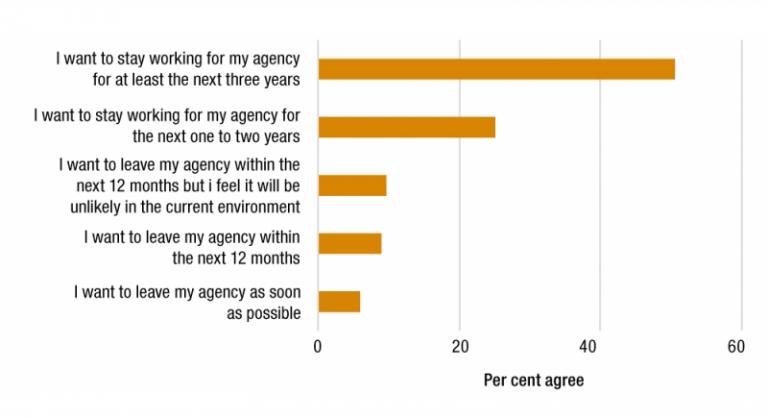
Source: 2019 APS employee census
The most common reasons employees selected for wanting to leave their agency were:
- perceived lack of future career opportunities (25 per cent)
- desire to try a different type of work or seek a career change (12 per cent)
- negative perceptions about the agency’s senior leadership (8 per cent).
APSED data indicates that during 2018–19 there were 12,100 separations of ongoing employees, the highest number since 2007–08. However, this fi ure also includes movement of employees from the Australian Signals Directorate out of coverage of the PS Act on 1 July 2018. Resignations accounted for the bulk of 2018–19 separations (38.8 per cent), followed by retrenchments (21.6 per cent) and age retirements (20.5 per cent).
Professions model
One mechanism for attracting, developing and retaining the capabilities the workforce requires is through a professions model. This approach is widespread in the United Kingdom civil service, which has identified 28 professions covering all civil service employees. The model has recently been implemented in New Zealand to lift policy capability in its public service.
A professions model provides a unifying framework for a rewarding public service career in a particular field. This includes clear identification of pathways for career advancement, along with opportunities for professional learning, development and networking. Each profession is led by a head of profession—a senior sector leader with overarching responsibility for capability identification and development.
The focus on career pathways means the professions model is consistent with other initiatives across the APS to foster talent and drive performance at all classification levels (see Chapter 1 for discussion of recent amendments to the Commissioner’s Directions; see Chapter 6 for discussion of talent management). Work has already started on professions in the APS, with an initial focus on the HR function, as well as digital and data-related roles.
Human resources
Recent reviews have highlighted enduring capability gaps within the APS HR function and have emphasised the need to focus on building and strengthening strategic HR skills across the service. This assessment has been confirmed through consultation and engagement to inform the APS-wide workforce strategy.
As external challenges and forces continue to shape the APS, the service will need the right workforce, structures and practices to be more adaptive and responsive to future requirements. The HR function—in particular, strategic workforce planning professionals—will play a critical role in driving and enabling successful transformation, and action is being taken to strengthen HR capability through development and implementation of a HR Professional Stream Strategy.
APS HR Professional Stream Strategy—Australian Public Service Commission and Australian Taxation Office
The APS HR Professional Stream Strategy was launched in October 2019. The strategy provides a systematic APS-wide approach to lifting strategic HR capability and leveraging skills and capability to improve overall performance of the APS for today and tomorrow.
The strategy will set and promote professional standards for HR in the APS, create a professional network of HR practitioners, connect and strengthen existing better practices across agencies, and create networks to strategically recruit, develop, grow and retain talent in the HR workforce.
An HR Head of Profession has been appointed to champion strategic HR capability development and strong collaboration across agencies. Other initiatives being progressed to bring the strategy to life and enable the momentum to grow and mature include:
- Streamlining HR Graduate recruitment for the APS
- Creating an HR Professional Network
- Implementing an HR mobility program
- Developing an HR workforce strategy.
This strengthened focus on building HR capability across the APS will improve the attraction, development, mobility and retention of capable people required to enable and drive organisations now and into the future.
Strategic workforce planning—Australian Financial Security Authority
The Australian Financial Security Authority is an executive agency in the Attorney-General’s portfolio, with broad-ranging services aimed at facilitating improved and equitable outcomes for consumers, business and the community, and contributing to the health and confidence of the Australian economy.
Over the past four years, the Authority has built its evidence-based workforce planning function and realigned its HR service delivery model to business strategy. This ensures that reliable workforce insights inform workforce planning conversations, and that workforce planning activities inform all workforce management strategies and initiatives. Strong partnerships within and outside the organisation have been key to this approach.
The Authority is a risk-based regulator. As a result, the agency’s workforce planning approach focuses on risk-based workforce management. This approach has resonated with the organisation’s business priorities and has enabled HR professionals to ‘speak the business language’ when rolling out workforce planning, linking these activities directly to immediate or long-term business strategies and deliverables.
Developing organisational capability in evidence-based workforce planning has been another priority, accompanied by an emphasis on benefit realisation and a strong culture of monitoring and evaluation. The adoption of enterprise-wide, self-service workforce analytics has been a critical driver of success for workforce planning capability development.
As a result of this significant investment in strategic workforce planning capability and approaches, the Authority is now in a solid position to anticipate and respond to future workforce challenges.
Digital
The world is changing, and Australia will need to adapt much more rapidly than in the past if it is to keep up. Nowhere is this more evident than in the role that new technologies, such as artificial intelligence, automation and life sciences, are playing in transforming established industries and creating new ones.
- Australian National Outlook 201988
Technology is advancing at an unprecedented pace, and has brought with it challenges to traditional ways of thinking, working and leading. The Australian National Outlook 2019 predicts that the impeding wave of digital technologies, including artificial intelligence and automation, will further change the way people live, interact and work.89
Through the 2019 APS agency survey, agencies across the service reported skills shortages and difficulty recruiting to a range of digital roles. Agencies also reported widespread difficulties accessing specialised learning and development to support upskilling. Expected growth in digital roles, and the increasing requirement for digital capability across various public sector professions, will only compound this issue.
Measures are being adopted across the APS to boost digital capability, spearheaded by the Government’s Digital Transformation Strategy90, but much work remains. APS employee census results show only 1 per cent of respondents self-identify as working in ‘digital’ roles, which includes those in cyber-security. Strategic, targeted recruitment of entry and mid-level digital specialists, as well as APS-wide supported reskilling, may be necessary to meet this growing demand.
To date, efforts to boost APS digital capability have focused mainly on the technical expertise of staff working in specific digital roles. The need to invest in world-class digital capability will continue in many areas of the APS and a digital professional model has the potential to attract digital professionals to the service, provide more fulfilling career opportunities, and assist government to deliver better outcomes to the public. The DTA and the APSC have commenced planning for this approach.
At the same time, as the importance and influence of digital approaches continues to increase, it will likely become necessary to consider a common approach to minimum digital capability requirements across the APS workforce. For example, the ability to manage cyber-security risks would already be seen by most agencies and APS employees as a de facto core public service competency. As digital enablers such as virtual collaboration and the ‘Internet of Things’ transition from the domain of innovation to business as usual, more and more APS employees will need to understand how best to take advantage of the benefits of digitalisation.
This aspect of the changing nature of work is likely to give rise to minimum standards of ‘digital literacy’ for the APS workforce. APS leaders will have an important role to play, not only in developing their own digital capability, but also in driving new digital approaches to their agency’s work.
Leading Digital Transformation Program—Australian Public Service Commission and Digital Transformation Agency
‘Digital leadership is leadership for the present and future.’
Leading Digital Transformation Program participant
In June 2018, the APSC, in collaboration with the DTA, started the Leading Digital Transformation Program. The program aims to strengthen SES officer capabilities to lead change and digital transformation in their agency.
The program focuses on current and future challenges and opportunities of leading in the digital age, and develops participants’ digital maturity. It also explores the benefits of disruptive and diverse thinking, and builds capability to drive agile working, digital transformation and plan and implement change. The program emphasises user-centred digital services and products, and the creation of public value through digital ways of working.
‘I have greater appreciation of the challenges and approaches to digital transformation across the APS.’
‘I am taking away a suite of tools I can practically apply to facilitate better/richer solutions.’
Leading Digital Transformation Program participants
A total of 268 APS SES (approximately 10 per cent of the cohort) have now attended the program with participants consistently reporting significant improvements in their ability to apply the principles of digital leadership to enable digital transformation in their agency. Participants have also highlighted the value of collaboration and peer learning.
Data
Data literacy has been identified as one of six core skills required to drive public sector innovation.91 Advances in data and analytics are impacting all sectors of the economy, and many agencies are struggling to keep up with demands and expectations from within and outside the APS.
All APS agencies use data and analytics to inform their work. This is not limited to specialised analytical teams—insights from data are becoming increasingly relevant and helpful to a wide variety of policy, program and corporate activities. Across the APS, large datasets represent a significant, but under-used asset and there is growing recognition of the need to improve the way agencies harness data to improve policy, program, regulatory and corporate outcomes.
A number of initiatives are under way to ensure agencies can gain greater benefit from the data they hold. The current focus of work taking place on APS data capability, including through the Secretaries Data Group, Deputy Secretaries Data Group and the Data Champions Network, is primarily on specialist data roles, some of which have been identified as areas of critical skills shortage by a number of agencies. This work is essential to ensure the APS can keep step with advances in data capability taking place in other sectors.
A likely outcome of work under way will be greater professionalisation of data roles and functions in the APS, including through consistent frameworks describing data and analytics capabilities. This approach will assist the service to attract and retain high quality employees to data-related roles. It will also enable the creation of career pathways to ensure the right balance of breadth and depth of experience.
At the same time, as with digital capability, minimum standards of data capability will become increasingly important for all APS employees, a significant majority of whom work with data at least some of the time. Even with pockets of highly trained data experts, each agency will need a broad degree of data literacy across its workforce to gain maximum benefit from the potential data has to offer.
Flexible work
Flexible work practices are another way to allow APS agencies to quickly adapt to the rapidly changing work environment, and support mobility and inclusivity. Flexible work also allows the APS to attract and retain capability as employees across multiple generations increasingly seek an enhanced work/life balance.
APS agencies provide a range of flexible working arrangements to support employees to modify when, where and how they work. Fifty-two per cent of respondents in the 2019 APS employee census indicated they currently access flexible work arrangements. Support for flexibility is widespread, with 83 per cent of respondents agreeing their supervisor actively supports the use of such arrangements by all staff, regardless of gender.
Current flexible work practices provide for adaptations to meet the different needs of each employee/employer relationship and can take various forms, including:
- flexible location through remote access, hot-desk set ups or the provision of laptop devices
- flexible hours such as compressed working weeks or reduced hours
- flexible leave such as flex time, purchased leave or time off in lieu
- flexible conditions including part-time agreements, career breaks, job-share arrangements, or individual flexibility agreements.
The value of flexible work to both the employee and the employer is widely recognised across the APS. The APS Gender Equality Strategy 2016–19 has driven a ‘flexible-by- default’ approach across the service, aiming to challenge traditional assumptions of how and where work should be performed. Part-time work agreements, individual flexibility agreements and remote work arrangements are accessible across the sector, and the APS agency survey shows the take-up of these initiatives is increasing.
Formal part-time hours are the most long-standing form of flexible work. Part-time APS employment is defined, for APSED reporting purposes, as employees who ordinarily work less than 35 hours per week. As at June 2019, data shows 16 percent of the total APS workforce worked part time.
APSED data shows that EL 2 participation in part-time work is markedly less at 8 per cent of the cohort, and this further decreases to 5 per cent at the SES level. However, the APS employee census data shows SES participation in broader flexible work arrangements, such as changes to work location, work hours or patterns of work, has increased by fi e percentage points to 40 per cent in 2019.
SES job sharing approaches—Australian Public Service Commission and Australian Bureau of Statistics
SES respondents to the 2019 APS employee census were more likely than staff at lower levels to see operational requirements as a barrier to participating in part-time work. However, some agencies have implemented approaches to facilitate part-time arrangements for SES officers, including formal job sharing.
Thirty SES respondents to the 2019 APS employee census indicated they were participating in job-sharing arrangements. Most of these arrangements involve two SES officers working on a permanent part-time basis. This is the case for the two co-group managers of the Inclusion and Implementation Group at the APSC.
In late 2018, the ABS implemented a slightly different approach. An EL 2 officer was formally promoted into a permanent part-time (two days a week) SES Band 1 position in the Communication and Parliamentary Branch, as part of a job-sharing arrangement with another permanent part-time SES Band 1 employee. However, the newly promoted SES officer retained their prior classification level of EL 2 for the remaining three days of the week.
This approach enabled the ABS to retain two high-performing employees while still meeting the operational requirements of the roles in question.
The 2019 APS employee census revealed that 41 per cent of APS employees have carer responsibilities. Of respondents with carer responsibilities, almost two-thirds also accessed flexible work arrangements. Employees aged 35 to 49 years who had carer responsibilities were more likely to care for children, whereas employees over the age of 55 were more likely to have carer responsibilities for parents or a partner.
Multigenerational workforce
According to the ABS, ‘the proportion of older people in Australia’s labour force has increased over the past 10 years, with the 2016 Census of Population and Housing revealing about 14 per cent of people aged 65 years and over were part of the labour force in 2016, up from 9.4 per cent in 2006’.92 The APS workforce continues to age in line with this trend, increasing from a mean age of 41.6 years in 2010 to 43.6 years in 2019 (Figure 5.4).
Figure 5.4: Mean age of APS employees, 2010 to 2019

Access to flexible work is a core component of enabling an APS workforce that now stretches across four generations. As APS employees stay longer in the workforce, it is imperative for the APS to embrace the skills and experience that older workers can offer.93 In the 2019 APS employee census, older employees were more likely to indicate they wanted to stay working for their agency for at least the next three years. They were also less likely to indicate that they had applied for a job outside the APS in the preceding 12 months.
Flexible working arrangements are likely to assist older workers nearing retirement, offering alternative options to stay engaged in the workplace or phased approaches to retirement. As older workers stay for longer in the workforce, ways in which to harness their skills and expertise include:
- developing mentoring/coaching programs to promote knowledge transfer between younger and older workers
- further promoting flexible work availability to accommodate older workers’ changing needs (that is, health, transitioning to retirement or caring responsibility)
- re-skilling older workers
- investing in lifelong learning to harness new ways of working.94
The APS needs to plan for a multigenerational workforce. Alongside a focus on critical workforce capabilities generally associated with a younger generation, a focus on recruiting and retaining older employees is needed to take advantage of their expertise and knowledge, so that the APS workforce reaches its full potential. Career pathways, job roles, talent management, learning and development will look different across generations. Understanding workforce motivators and reward systems will also be central to enhancing workforce engagement and wellbeing in the years to come.
Employee engagement
[Engaged employees] willingly go the extra mile, work with passion, and feel a profound connection to their company. They are the people who will drive innovation and move your business forward.
Gallup Business Journal: Five Ways to Improve Employee Engagement Now 95
Employee engagement is more than job satisfaction; it is about employees’ emotional commitment to their organisation and the contribution they seek to make to organisational outcomes. Research shows that high levels of employee engagement provide positive benefi s to organisations—engaged employees feel motivated to contribute to agency-level outcomes, are often more productive, and foster a positive, high-performing organisational culture.96
The APS employee census generates an overall engagement index score from responses to questions against three aspects of employee engagement (Figure 5.5). In 2019, the APS-wide engagement index score was 72 per cent. This represents an increase of two percentage points from 2018.
Figure 5.5: Engagement index items
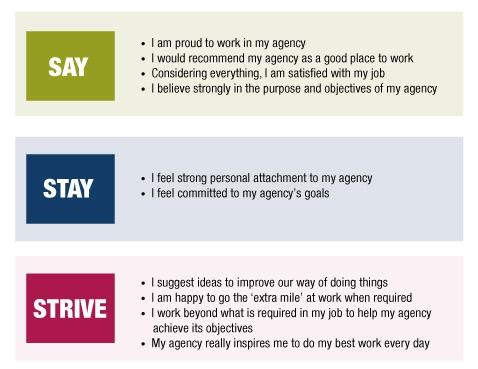
The index can also be used to illustrate key factors influencing employee engagement at agency level. For example, Figure 5.6 demonstrates the relationship between the employee engagement index and employees’ line of sight from their role to the delivery of outcomes to the Australian public.
Figure 5.6: APS employee engagement index score against perceptions of role/purpose
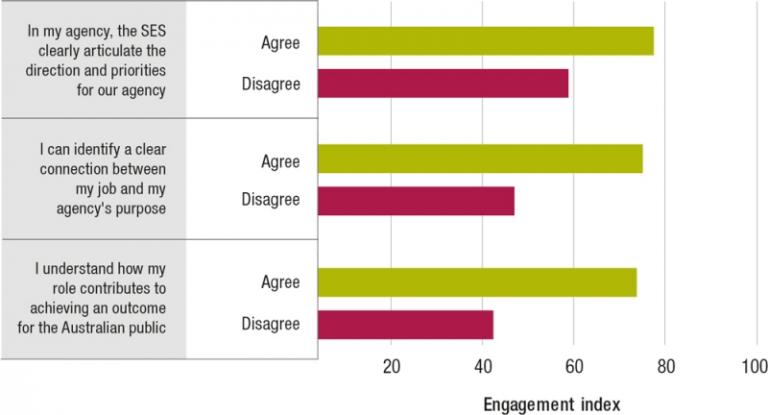
Source: 2019 APS employee census
When agencies with the highest and lowest engagement scores were compared, the most significant differentiating characteristic was the extent to which employees felt valued for the contribution they make. This comparison also highlighted the important part that SES play in employee engagement (Figure 5.7).
Figure 5.7: Percentage point differences between the top and bottom 10 agencies for engagement
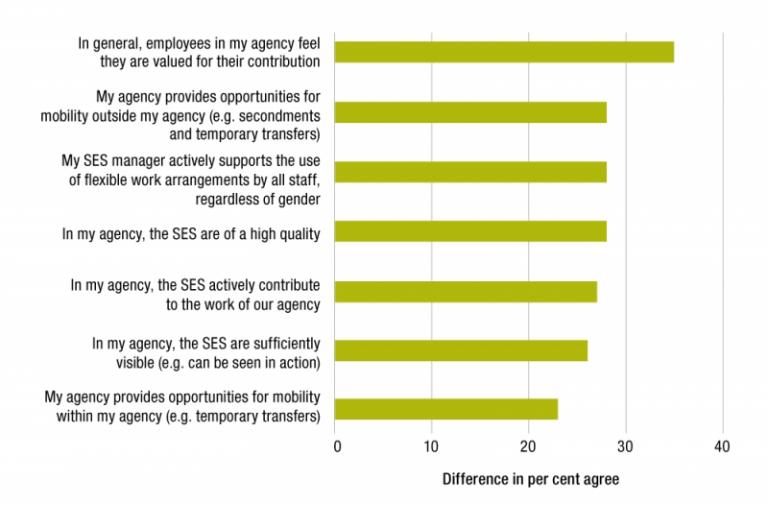
Source: 2019 APS employee census
Wellbeing
When employees enjoy a happy, healthy work environment, you start seeing exciting innovations in business. It’s the difference between an organisation that’s simply functioning and an organisation that’s capable of making huge leaps. It really comes down to the people who are working within it.
Dr Amanda Allisey, Deakin University97
As an employer, the APS has a role in promoting and maintaining the health and wellbeing of its employees. Wellbeing combines aspects of physical, mental, and social health and is influenced by an individual’s overall happiness and satisfaction with life. Employee wellbeing influences performance, engagement and productivity. Besides benefiting employees, a healthy and engaged workplace is more productive and leads to enhanced organisational outcomes. Research shows that having sound psychological wellbeing levels positively correlates to enhanced work performance.98
The 2019 APS employee census included questions relating to practical and cultural elements that allow for a sustainable and healthy working environment. Responses were broadly positive and indicated that perceptions of promotion of wellbeing in the workplace have increased from previous years. However, there is clearly more to be done at whole-of-agency level, with less than 60 per cent of respondents agreeing their agency cares about their health and wellbeing (Figure 5.8).
Figure 5.8: APS employee perceptions of wellbeing, 2017 to 2019
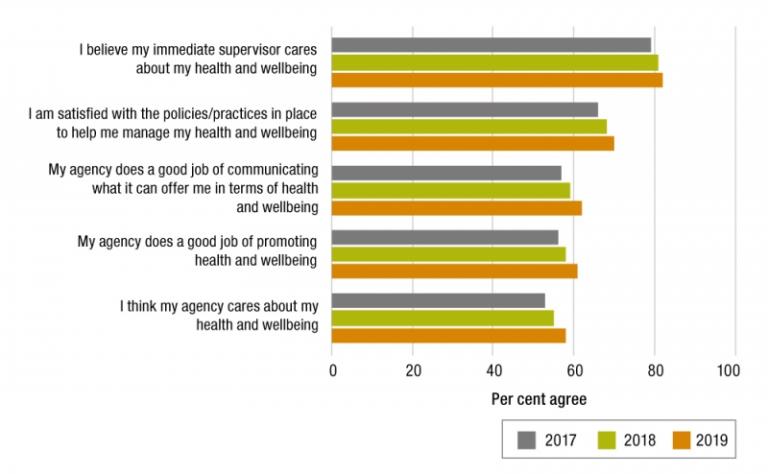
Source: APS employee census
Responses to the five wellbeing related questions in Figure 5.8 were used to calculate a wellbeing index score. The overall index for the APS in 2019 was 67 per cent, a one percentage point increase from 2018 and a two percentage point increase from 2017. Other wellbeing related questions in the 2019 APS employee census also paint a broadly positive picture of APS employees’ work environment (Figure 5.9).
Figure 5.9: APS wellbeing snapshot
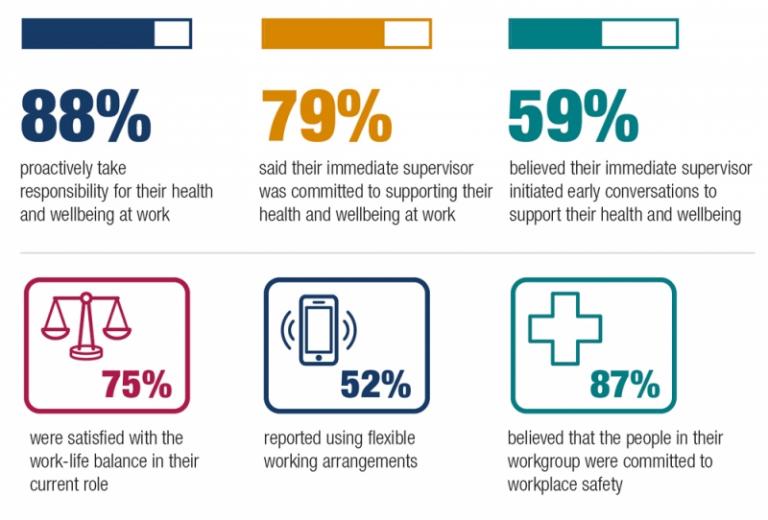
Source: 2019 APS employee census
In December 2018, the Fair Work Amendment (Family and Domestic Violence Leave) Act 2018 (Cwlth) took effect, providing all employees with an entitlement to five days unpaid family and domestic violence leave as part of the National Employment Standards.99 In addition, the Workplace Bargaining Policy 2018100 encourages Commonwealth agencies to put in place policies and practices that provide maximum support to employees affected by family and domestic violence, using the existing range of generous conditions in enterprise agreements, such as miscellaneous leave.
The 2019 APS agency survey responses show that 65 per cent of APS agencies reported having a domestic and family violence action plan, strategy and/or policy in place during 2018–19.
Family and domestic violence policy—Services Australia
The Services Australia Family and Domestic Violence Strategy 2016–2019 underpins its commitment to supporting staff and customers who are at risk of, or experiencing, family and domestic violence (FDV).
The department has established a Staff FDV Contact Line where staff and managers access tailored advice and support from trained contact officers. Support includes referrals for assistance, safety planning, advice on leave options (including flexible working arrangements), compassionate transfers and relocation assistance where it is essential for the safety of the employee and family. Staff can also be referred to the Employee Assistance Program, which provides free, confidential and professional counselling for employees and their family members.
The department provides leave options to employees affected by FDV, in addition to existing leave entitlements:
- attending court hearings (such as for Apprehended Violence Orders and Domestic Violence Orders)
- attending meetings with the police (where the employee is a victim of violence)
- gaining emergency accommodation
- attending other legal, police, financial, housing requirements relating to being a victim of violence.
Miscellaneous leave (unpaid), up to five days per year if:
- the employee is experiencing FDV
- the employee needs to do something to deal with the impact of the FDV
- it is impractical for the employee to do that thing outside their ordinary hours of work.
Miscellaneous leave (special), up to two days, if the employee needs to:
- move out of their house immediately, and the timing or opportunity is unplanned
- attend to their needs or the needs of their children, and the timing or opportunity is unplanned and the circumstances do not fit into other categories of leave.
Front-line staff receive training to identify customers at risk of FDV and provide options for support. Six targeted training courses are available for employees, including facilitated sessions and self-paced e-learning modules.
The next iteration of the department’s Family and Domestic Violence Strategy 2020–23 is under development, building on achievements to date in offering targeted support for vulnerable groups and those at risk of or affected by FDV. The new strategy will drive the department’s continual engagement within government and the community. It is expected to launch in early 2020.
Workplace relations
Each APS agency is responsible for establishing and maintaining its own workplace relations arrangements governing wages and conditions, within the broader legislative and policy framework. These arrangements cover enterprise agreements, common law agreements and determinations applicable to APS employees.
The Government’s Workplace Bargaining Policy 2018 supports sustainable, high-performing public service workplaces through a series of key principles. The policy provides agencies with flexibility to best suit the needs of their employees and business. There is a continued focus on flexible work practices, modest remuneration increases and reflecting community standards.
One option some agencies and their employees have considered and adopted is to make a determination that sits on top of a nominally expired enterprise agreement to provide pay increases. This option allows the terms and conditions of the underlying enterprise agreement to continue with increases in pay and allowances provided through a determination made by the agency head. It continues all the rights and protections available to employees under the Fair Work Act 2009 (Cwlth).
It is essential that agencies consult with employees and obtain their support before proceeding with a determination. However, the time and resources required to engage with employees to gauge their support is significantly less than negotiating a new enterprise agreement.
On 30 October 2018, following consultation with multiple agencies, the APS Commissioner advised of a change to the application of the bargaining policy, to provide agencies discretion in applying the first pay increase of newly approved enterprise agreements. Once an enterprise agreement has been approved by the Fair Work Commission, the first pay increase may have an application date of 12 weeks from the successful employee ballot for the agreement. This ensures employees receive timely, fair pay increases after voting up new agreements.
In 2018–19, employees in 22 APS agencies voted up new enterprise agreements. Another 19 agencies received the APS Commissioner’s approval to make determinations on top of nominally expired enterprise agreements to provide pay increases, with the support of their employees.
Generally strong employee support for recent enterprise agreement ballots, support for determinations in lieu of bargaining and a low level of protected industrial action over 2018–19 suggests that employees are largely satisfied with their terms and conditions of employment. Increasing use of determinations also reflects recent APS employee census results that 77 per cent of employees are satisfied with their non-monetary employment conditions.
Twenty-nine APS enterprise agreements will reach their nominal expiry dates in 2019–20.



